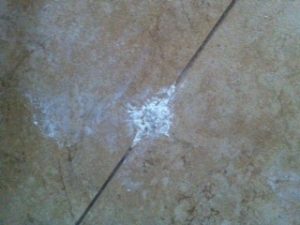Efflorescence and Calcium Deposits

What is Efflorescence, it is the crystalline deposit of soluble salts that appears on the surface of porous building materials such as concrete, brick, stucco, tile, or natural stone. It presents as a white or grayish powder, often mistaken for mold or surface staining. In reality, efflorescence is a chemical process triggered by moisture migration through cement-based materials.
The word efflorescence comes from the French phrase “to flower out,” describing the way salts migrate to the surface and bloom into visible crystals. The most common form is calcium hydroxide [Ca(OH)₂] leaching out of Portland cement. When moisture evaporates at the surface, it reacts with atmospheric carbon dioxide to form calcium carbonate [CaCO₃] — a hard, stubborn deposit.
The Chemistry Behind Efflorescence
- Moisture transport: Water penetrates concrete pores (porosity 10–25%) and dissolves soluble salts.
- Capillary action: Water moves upward or outward through microscopic capillaries, carrying ions with it.
- Surface evaporation: As water evaporates, salts crystallize at the surface.
- Chemical reaction: Calcium hydroxide + CO₂ → Calcium carbonate (hard efflorescence).
Typical concentrations: even at 0.5% soluble salts by mass, Calcium carbonate formation can coat surfaces visibly within weeks of exposure. Capillary rise can move water at rates exceeding 1 m/day in fine-grained concrete. This explains why white deposits may appear far from the original water entry point.
Reference: Portland Cement Association – Efflorescence
Why Calcium Carbonate Formation Matters

- Aesthetic issues: White staining reduces property value.
- Durability risk: Persistent Calcium carbonate formation signals foundation cracks or uncontrolled water entry.
- Spalling: When calcium hydroxide crystallizes beneath the surface, expansive pressures can cause flaking or delamination.
- Rebar corrosion: Chloride-rich efflorescence indicates that water may be reaching reinforcing steel, which begins to rust at relative humidity levels above ~60%.
EPA notes that uncontrolled indoor humidity can lead to both Salt deposition and mold growth within 24–48 hours, compounding risks.
Can Efflorescence Be Cleaned?
Yes — but removal is a treatment, not a cure. Fresh Salt deposition may be removed with dry brushing or low-pressure water. Acid washes (e.g., diluted hydrochloric or phosphoric acid) can dissolve calcium carbonate but risk etching surfaces. Once calcium hydroxide fully carbonates, deposits become nearly impossible to remove mechanically.
The key is eliminating the water source: vapor barriers under slabs, drainage improvements, crack injection, and wall waterproofing membranes. Without moisture migration, salts cannot transport to the surface.
Permanent Solutions for Efflorescence & Calcium Deposits
White, chalky deposits on concrete, brick, stucco, or stone aren’t just cosmetic — they signal ongoing water movement through your structure. Florida’s humid climate, frequent rainfall, and high water table create ideal conditions for soluble salts to migrate and form efflorescence. Left untreated, this moisture movement can lead to deeper issues such as surface scaling, spalling, and even reinforcing steel corrosion. Over time, that means weakened walls, compromised slabs, and costly structural repairs.
At Foundation Waterproofing 101, every efflorescence investigation is led by licensed water hydraulics engineer Jeff Earl. We identify the exact source of moisture — whether it’s groundwater wicking up through a slab, rainwater penetrating porous masonry, or vapor drive from Florida’s saturated soils. Our recommendations are based on real field data and proven building science, not guesswork.
Our repair approach can include exterior drainage improvements, installation of vapor barriers beneath slabs, foundation crack injection, and application of professional waterproofing membranes or sealers. We also advise on proper indoor humidity control to prevent continued salt migration and related mold growth. Where deposits have already formed, we can safely clean and restore surfaces while ensuring the root cause is addressed so new staining does not return.
Efflorescence is an early warning sign you shouldn’t ignore. Schedule a professional inspection today or call 813-614-4830 to protect your foundation and exterior finishes before moisture causes structural damage or expensive deterioration.
Foundation Waterproofing 101 – Your Florida Efflorescence Experts
If you see white powder, crystalline film, or calcium deposits on your tile, stucco, or foundation walls, this is an early warning sign of water intrusion. At Foundation Waterproofing 101, we understand the chemistry and mechanics of efflorescence and can design permanent solutions to stop it at the source.
???? Call 813-614-4830 today for an inspection and consultation.
